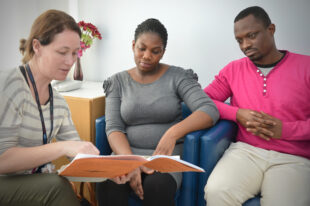Are you involved in antenatal sickle cell and thalassaemia (SCT) screening?
Do you counsel women and couples at risk of having a baby with a significant haemoglobin disorder?
Are you aware of all the resources available to support your counselling?
The SCT antenatal programme screens pregnant women to find out if they’re at risk of having a baby with sickle cell disease or thalassaemia major, which are serious inherited blood conditions. This gives parents time to consider the options available.
In 2014 we produced 2 patient information leaflets to support healthcare professionals.
- Women and couples at risk of having a baby with sickle cell disease
- Women and couples at risk of having a baby with thalassaemia

We are reviewing these leaflets, to make sure they provide the right information for both healthcare professionals and the public.
Please complete our short questionnaire so we know if you are aware of the leaflets, if you use them, and what you think of them. We will use your responses to make the leaflets better. The deadline for responding is Monday 27 March.
Thank you for helping us and we look forward to reading your comments.
PHE Screening blog
PHE Screening BLOG articles provide up to date news from all NHS screening programmes – replacing our previously published newsletters.
You can register to receive updates direct to your inbox, so there’s no need to keep checking for new blog articles.
2 comments
Comment by Irene Stratton posted on
I do hope that the views of women and their partners are also being sought. I've worked in the area of screening for many years and shared an office with those working on some of the first ante-natal screening programmes 35 years ago - and I now work with clinical biochemists on blood conditions including abnormal HbA1c. However I don't find these current leaflets very easy to read and I am sure that if I didn't speak English fluently I would have even more of a problem. Does everyone know what a "trained health professional" is? As a statistician who has worked in the area of how to explain risk to those being screened I have read a lot around the area and it's clear from the work of Gigerenzer and others that these concepts are not easy to understand - in fact ante-natal screening is one of the topics discussed in one of the papers. It proved to be impossible to explain what a 1 in 100 risk or 1 in 1000 risk was to many of them. A quarter of the adult population have numeracy levels such that they cannot understand percentages.
So - I do hope that a multi-ethnic all-ability group of parents is included in the consultation.
Comment by Cathy Coppinger posted on
Dear Irene,
Thank you for your comments. In reviewing these leaflets, we are very keen to make sure they are clear and concise and enable pregnant women and their partners to make informed choices. We are convening a multi-ethnic public focus group to help us develop updated resources that are fit for purpose. Understanding of risk and data will be one of the most important issues that this group will examine.
Kind regards,